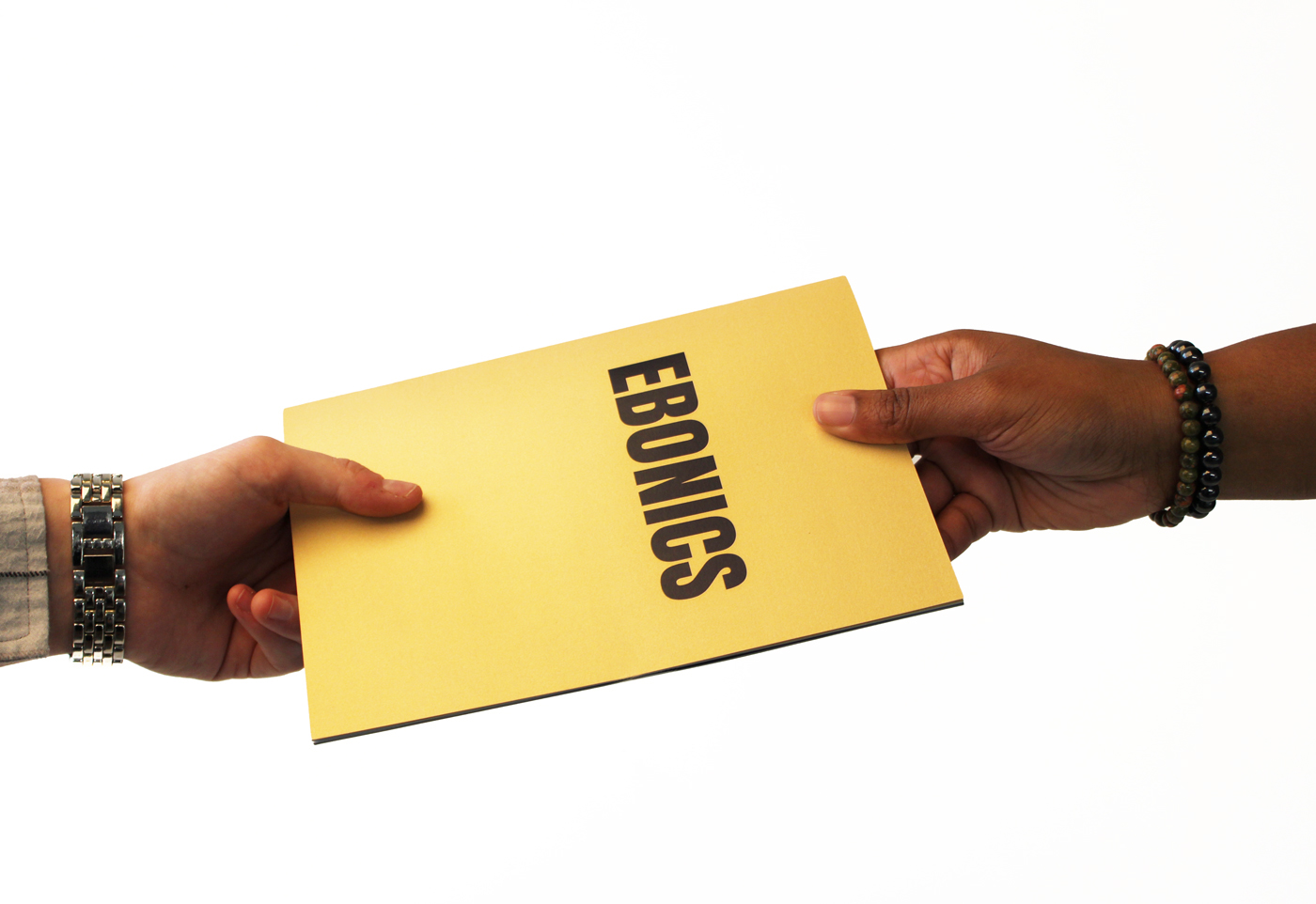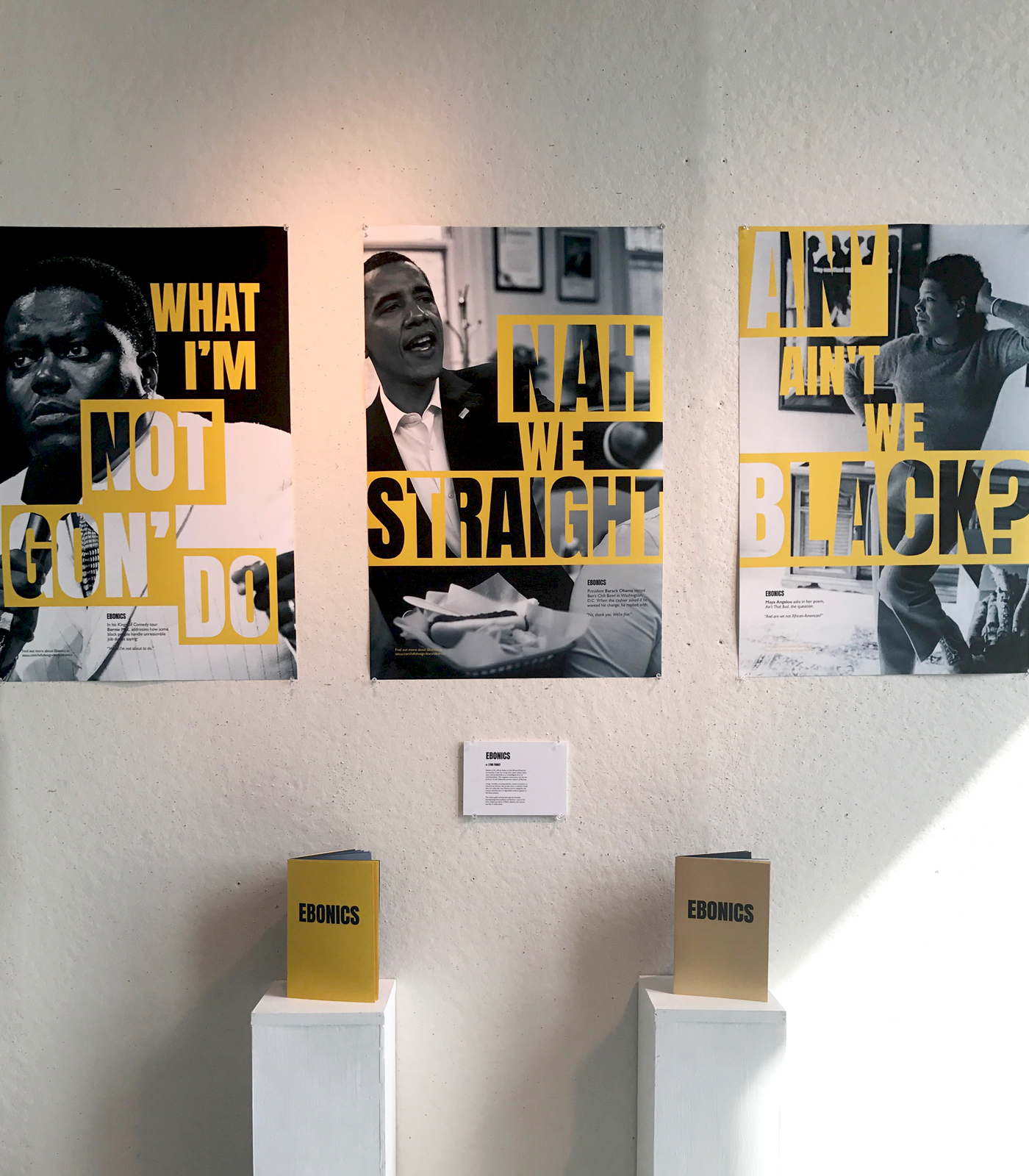
Thesis Statement
Ebonics is the official dialect of the African-American community. It has, for a long time, been looked down upon and condemned as an unintelligent form of communication. This negative connotation has led me to focus on the inherently positive aspects of Ebonics. Using a booklet, accompanied by a series of posters as educational devices this project aims to educate those who are unfamiliar with Ebonics and to enlighten the masses that Ebonics is a legitimate mode of speech of the Black people.

Image of booklet dressed in metallic gold.
Intent
If people embraced Ebonics, or code switching, they could have a positive connotation towards the dialect instead of thinking of it as slang, or “ghetto talk.” Choosing an approach wisely to bring a better outlook on Ebonics could meet the needs of people who speak Ebonics proudly, like Obama during his presidency. Knowing Standard American English and Ebonics together could potentially help others, no matter what race, and embrace diversity as well as note one of the most important facets of Black identity and culture worthy of celebrating. This thesis project is expanded through examples of empowered role models using Ebonics. Further and extensive research on the history and background of Ebonics is exposed through the booklet and potentially gravitates people into learning about the positives aspects of Ebonics.
My goal is to inform others how Ebonics derived from English and how it differs from other informal languages. My target audience is those who have a negative connotation towards Ebonics or who don't know it.

Image of booklet focusing on the usage of Ebonics.

A few inside pages in the booklet on the origin and rules of Ebonics.

Final poster for Barack Obama.

(3) Final poster series
Left Bernie Mac
Right Maya Angelou

Alternate color system, gold changed into a yellow.
Research
To start this project I did research on the pros and cons of Ebonics. I wanted to gain more knowledge on why people did or did not like Ebonics. Through sources and interviews a reason for not liking Ebonics is because of the confusion between justifying Ebonics as slang, or jargon, even though it is a legitimate dialect. The colors gold and blue are used to pervade the booklet and poster series, representing the excellence of Ebonics and celebration for the black identity. From interviewing, thinking of ways to put Ebonics in a positive light and immersing myself in the marketing tactics of corporate companies using Ebonics, I produced a empowering message dedicated to Black culture and Ebonics.
Ebonics was coined in 1973’ because of a group of scholars who disliked the negative connotations of terms like “Nonstandard Negro English.” Dr. Robert Williams, a professor of Psychology at Washington University, who was sick and tired of white people writing the learning deficiencies of African Americans paved the way for Ebonics to exist. Williams sought out to prove that Ebonics is a true and real language of Black Americans and that the primary purpose of the dialect was to communicate, think critically and analytically and solve problems. Ebonics, also known as an African American Vernacular English (AAVE), is considered to be a dialect that you learn within a home setting and not looked at as slang or jargon.
Steven Willis poem inspired this project.

Sketches and brainstorming on how to put Ebonics into a positive, as well as, educational perspective.

My initial research brought me to use Black role models: Barack Obama, Maya Angelou, and Bernie Mac, within society that actually spoke Ebonics in public.

Final direction for typeface, Anton.
The boldness and condensed purpose of this typeface gives an Urban feeling as well as refined approach to the topic.

Final set up with booklet accompanied by poster set.
Conclusion
Overall I am very proud that I was able to change negative or unknown perspectives of many. I believe I came to a conclusive idea in hopes of continuing the chain of poster series in the future and dressing them in metallic gold to embrace the celebration of excellence. My final solution is arranged for those that appreciate their identity and those who are not knowledgeable of Ebonics. On going from here, I plan to generate more positive aspects of Ebonics through more posters, acknowledging those who use Ebonics proudly, and unite people while embracing diversity.
References
Written
Written
Andersen, M. (2017). Why Can't the U.S. Decolonize Its Design Education? Retrieved from http://eyeondesign.aiga.org/why-cant-the-u-s-decolonize-its-design-education/
Baugh, J. (2000). Beyond Ebonics: Linguistic Pride and Racial Prejudice. Oxford: Oxford University Press.
Dr.Johnson. U. (2014). The Influence of Ebonics on the Hip-Hop Culture Retrieved from https://www.youtube.com/watch?v=vd5sYtFTRdA
Gresham, L. (2014). "Don’t You Be Telling Me How Tah Talk: Education, Ebonics, and Code-switching" (2014). Honors Theses
Mcwhorter, J. (2011)."What's Up" Provides A Lesson In Ebonics.” The Root. Retrieved from http://www.npr.org/2011/04/27/135764774/the-root-whats-up-provides-a-lesson-in-ebonics
Mo. (2012). A Black Aesthetic in Graphic Design Retrieved from http://cargocollective.com/mowoods/filter/Black/EBAGD-Chapter3-A-Black-aesthetic-in-Graphic-Design
Visual
Berardi, A. (2014). FUCK*IN HIP HOP. Retrieved from https://www.behance.net/gallery/16770405/FUCKIN-HIP-HOP
Bobbera. Giada (2011). Language and Typography. Retrieved from https://www.behance.net/gallery/1071023/Language-and-typography
Curzan, A. (2005). What Makes a Word “Real” Retrieved from
http://tedtalkspsychology.com/what-makes-a-word-real-with-anne-curzan/
Lyiscott, J. (2014). 3 Ways to Speak English Retrieved from https://www.ted.com/talks/jamila_lyiscott_3_ways_to_speak_english#t-5196
Willis. S. (2015). Ebonics 101 Retrieved from
https://www.youtube.com/watch?v=CB8pBiUavtg







